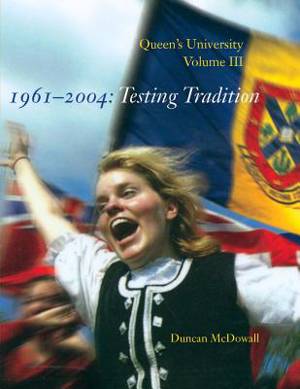
- Afhalen na 1 uur in een winkel met voorraad
- Gratis thuislevering in België vanaf € 30
- Ruim aanbod met 7 miljoen producten
- Afhalen na 1 uur in een winkel met voorraad
- Gratis thuislevering in België vanaf € 30
- Ruim aanbod met 7 miljoen producten
Zoeken
€ 106,95
+ 213 punten
Omschrijving
Founded in 1841 by a royal charter, Queen's University evolved into a national institution steeped in tradition and an abiding sense of public service. Propelled initially by its Presbyterian instincts and an attachment to Gaelic culture, Queen's has prospered and adapted over the years to match Canada's ever-changing dynamics. In this third volume of Queen's University's official history, Duncan McDowall demonstrates that the late twentieth century was a contest between expediency and tradition waged through crisis and careful evolution. Testing Tradition calibrates the durability of Queen's vaunted traditions in the face of shifts in the broader Canadian society. During this time of massive postsecondary expansion, Queen's grew sevenfold from a small, collegial campus of 3,100 students to a sprawling cosmopolitan place of more than 20,000 students from over 120 countries engaged in undergraduate, graduate, and professional programs. Measuring Queen's University's responses to concerns over social diversity, human rights, and gender equity through the eyes of its trustees, administrators, students, faculty, and the Kingston community, this volume pays particular attention to the experiences of women and visible minorities at the university. Copiously illustrated with photographs of important people, events, and aspects of campus life, this volume shows how Queen's, in having its traditions tested, has worked to retain the best of its past, while accepting the inevitability of change.
Specificaties
Betrokkenen
- Auteur(s):
- Uitgeverij:
Inhoud
- Aantal bladzijden:
- 592
- Taal:
- Engels
Eigenschappen
- Productcode (EAN):
- 9780773546967
- Verschijningsdatum:
- 30/06/2016
- Uitvoering:
- Hardcover
- Formaat:
- Genaaid
- Afmetingen:
- 224 mm x 279 mm
- Gewicht:
- 2267 g

Alleen bij Standaard Boekhandel
+ 213 punten op je klantenkaart van Standaard Boekhandel
Beoordelingen
We publiceren alleen reviews die voldoen aan de voorwaarden voor reviews. Bekijk onze voorwaarden voor reviews.








